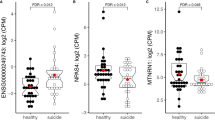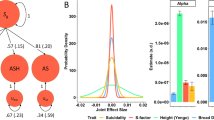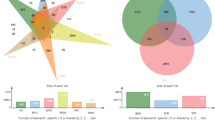Abstract
Genetic factors have been suggested to be involved in suicide. Although some genetic factors, such as serotonergic transduction, have been associated with suicide, the results are inconsistent. There is a possibility that various signaling anomalies are involved in the biological vulnerability to suicide. We carried out a genome-wide gene-expression study in the brains of suicide victims using DNA microarrays;14-3-3 ε, which is related to neurogenesis, was one of the genes upregulated in the brains of suicide victims in the microarray analysis. This was confirmed by Western blot analysis. To examine the possibility of the involvement of 14-3-3 ε in the pathogenesis of suicide, we investigated the association of the 14-3-3 ε gene and completed suicide. We used three high-frequency SNPs (rs1532976, rs3752826, and rs9393) and found a significant association of two alleles (rs1532976 and rs3752826) with completed suicide (p < 0.05). Moreover, the distribution of haplotype revealed a more significant difference between completed suicide and controls (p=0.0005). This finding suggests that 14-3-3 ε is a potential suicide susceptibility gene and implies that dysregulation of neurogenesis may be involved in suicide.
Similar content being viewed by others
Log in or create a free account to read this content
Gain free access to this article, as well as selected content from this journal and more on nature.com
or
References
Anguelova M, Benkelfat C, Turecki GA (2003) Systematic review of association studies investigating genes coding for serotonin receptors and the serotonin transporter: II. Suicidal behavior. Mol Psychiatry 8:646–653
Asberg M (1997) Neurotransmitters and suicidal behavior. The evidence from cerebrospinal fluid studies. Ann NY Acad Sci 29:158–181
Asberg M, Traskman L, Thoren P (1976) 5-HIAA in the cerebrospinal fluid. A biochemical suicide predictor? Arch Gen Psychiatry 33:1193–1197
Baldessarini RJ, Tondo L, Hennen J (2001) Treating the suicidal patient with bipolar disorder. Reducing suicide risk with lithium. Ann NY Acad Sci 932:24–38; discussion 39–43
Bellivier F, Chaste P, Malafosse A (2004) Association between the TPH gene A218C polymorphism and suicidal behavior: a meta-analysis. Am J Med Genet 1 124B:87–91
Berg D, Holzmann C, Riess O (2003) 14-3-3 proteins in the nervous system. Nat Rev Neurosci 4:752–762
Bernier PJ, Bedard A, Vinet J, Levesque M, Parent A (2002) Newly generated neurons in the amygdala and adjoining cortex of adult primates. Proc Natl Acad Sci USA 20 99:11464–11469
Brezun JM, Daszuta A (1999) Depletion in serotonin decreases neurogenesis in the dentate gyrus and the subventricular zone of adult rats. Neuroscience 89:999–1002
Cheetham SC, Crompton MR, Czudek C, Horton RW, Katona CL, Reynolds GP (1989) Serotonin concentrations and turnover in brains of depressed suicides. Brain Res 20 502:332–340
Chen G, Rajkowska G, Du F, Seraji-Bozorgzad N, Manji HK (2000) Enhancement of hippocampal neurogenesis by lithium. J Neurochem 75:1729–1734
Chen HK, Fernandez-Funez P, Acevedo SF, Lam YC, Kaytor MD, Fernandez MH, Aitken A, Skoulakis EM, Orr HT, Botas J, Zoghbi HY (2003) Interaction of Akt-phosphorylated ataxin-1 with 14-3-3 mediates neurodegeneration in spinocerebellar ataxia type 1. Cell 16 113:457–468
Gaspar P, Cases O, Maroteaux L (2003) The developmental role of serotonin: news from mouse molecular genetics. Nat Rev Neurosci 4:1002–1012
Goodwin FK, Fireman B, Simon GE, Hunkeler EM, Lee J, Revicki D (2003) Suicide risk in bipolar disorder during treatment with lithium and divalproex. JAMA 17 290:1467–1473
Gould E (1999) Serotonin and hippocampal neurogenesis. Neuropsychopharmacology 21(2 Suppl):46S-51S
Gould E, McEwen BS, Tanapat P, Galea LA, Fuchs E (1997) Neurogenesis in the dentate gyrus of the adult tree shrew is regulated by psychosocial stress and NMDA receptor activation. Neurosci 1 17:2492–2498
Gould E, Tanapat P, McEwen BS, Flugge G, Fuchs E (1998) Proliferation of granule cell precursors in the dentate gyrus of adult monkeys is diminished by stress. Proc Natl Acad Sci USA 17 95:3168–3171
Haga H, Yamada R, Ohnishi Y, Nakamura Y, Tanaka T (2002) Gene-based SNP discovery as part of the Japanese millennium genome project: identification of 190,562 genetic variations in the human genome. Single-nucleotide polymorphism. J Hum Genet 47:605–610
Halim ND, Weickert CS, McClintock BW, Weinberger DR, Lipska BK (2004) Effects of chronic haloperidol and clozapine treatment on neurogenesis in the adult rat hippocampus. Neuropsychopharmacology 29:1063–1069
Hirakawa M, Tanaka T, Hashimoto Y, Kuroda M, Takagi T, Nakamura Y (2002) JSNP: a database of common gene variations in the Japanese population. Nucleic Acids Res 1 30:158–162
Hrdina PD, Demeter E, Vu TB, Sotonyi P, Palkovits M (1993) 5-HT uptake sites and 5-HT2 receptors in brain of antidepressant-free suicide victims/depressives: increase in 5-HT2 sites in cortex and amygdala. Brain Res 18 614(1, 2):37–44
Ichimura T, Uchiyama J, Kunihiro O, Ito M, Horigome T, Omata S, Shinkai F, Kaji H, Isobe T (1995) Identification of the site of interaction of the 14-3-3 protein with phosphorylated tryptophan hydroxylase. J Biol Chem 1 270:28515–28518
Iwamoto K, Kakiuchi C, Bundo M, Ikeda K, Kato T (2004) Molecular characterization of bipolar disorder by comparing gene expression profiles of postmortem brains of major mental disorders. Mol Psychiatry 9:406–416
Jacobs BL, Praag H, Gage FH (2000) Adult brain neurogenesis and psychiatry: a novel theory of depression. Mol Psychiatry 5:262–269
Jia Y, Yu X, Zhang B, Yuan Y, Xu Q, Shen Y, Shen Y (2004) An association study between polymorphisms in three genes of 14-3-3 (tyrosine 3-monooxygenase/tryptophan 5-monooxygenase activation protein) family and paranoid schizophrenia in northern Chinese population. Eur Psychiatry 19:377–379
Kim JS, Chang MY, Yu IT, Kim JH, Lee SH, Lee YS, Son H (2004) Lithium selectively increases neuronal differentiation of hippocampal neural progenitor cells both in vitro and in vivo. J Neurochem 89:324–336
Malone KM, Corbitt EM, Li S, Mann JJ (1996) Prolactin response to fenfluramine and suicide attempt lethality in major depression. Br J Psychiatry 168:324–329
Mann JJ, Oquendo M, Underwood MD, Arango V (1999) The neurobiology of suicide risk: a review for the clinician. J Clin Psychiatry 60(Suppl) 2:7–11; discussion 18–20, 113–116
Meltzer HY (2001) Treatment of suicidality in schizophrenia. Ann NY Acad Sci 932:44–58; discussion 58–60
Meltzer HY, Alphs L, Green AI, Altamura AC, Anand R, Bertoldi A, Bourgeois M, Chouinard G, Islam MZ, Kane J, Krishnan R, Lindenmayer JP, Potkin S (2003) International suicide prevention trial study group. Clozapine treatment for suicidality in schizophrenia: international suicide prevention trial (InterSePT). Arch Gen Psychiatry 60:82–91
Muller-Oerlinghausen B, Berghofer A, Bauer M (2002) Bipolar disorder. Lancet 19 359(9302):241–247
Ono H, Shirakawa O, Kitamura N, Hashimoto T, Nishiguchi N, Nishimura A, Nushida H, Ueno Y, Maeda K (2002) Tryptophan hydroxylase immunoreactivity is altered by the genetic variation in postmortem brain samples of both suicide victims and controls. Mol Psychiatry 7:1127–1132
Roy A, Segal NL, Centerwall BS, Robinette CD (1991) Suicide in twins. Arch Gen Psychiatry 48:29–32
Tanapat P, Galea LA, Gould E (1998) Stress inhibits the proliferation of granule cell precursors in the developing dentate gyrus. Int J Dev Neurosci 16:235–239
Toyo-oka K, Muratake T, Tanaka T, Igarashi S, Watanabe H, Takeuchi H, Hayashi S, Maeda M, Takahashi M, Tsuji S, Kumanishi T, Takahashi Y (1999) 14-3-3 protein eta chain gene (YWHAH) polymorphism and its genetic association with schizophrenia. Am J Med Genet 16 88:164–167
Toyo-oka K, Shionoya A, Gambello MJ, Cardoso C, Leventer R, Ward HL, Ayala R, Tsai LH, Dobyns W, Ledbetter D, Hirotsune S, Wynshaw-Boris A (2003) 14-3-3epsilon is important for neuronal migration by binding to NUDEL: a molecular explanation for Miller-Dieker syndrome. Nat Genet 34:274–285
Wender PH, Kety SS, Rosenthal D, Schulsinger F, Ortmann J, Lunde I (1986) Psychiatric disorders in the biological and adoptive families of adopted individuals with affective disorders. Arch Gen Psychiatry 43:923–929
Wong AH, Macciardi F, Klempan T, Kawczynski W, Barr CL, Lakatoo S, Wong M, Buckle C, Trakalo J, Boffa E, Oak J, Azevedo MH, Dourado A, Coelho I, Macedo A, Vicente A, Valente J, Ferreira CP, Pato MT, Pato CN, Kennedy JL, Van Tol HH (2003) Identification of candidate genes for psychosis in rat models, and possible association between schizophrenia and the 14-3-3 eta gene. Mol Psychiatry 8:156–166
Young LT, Bezchlibnyk YB, Chen B, Wang JF, MacQueen GM (2004) Amygdala cyclic adenosine monophosphate response element binding protein phosphorylation in patients with mood disorders: effects of diagnosis, suicide, and drug treatment. Biol Psychiatry 15 55:570–577
Acknowledgements
This research was supported by a Research Grant for Nervous and Mental Disorders from the Ministry of Health, Labor and Welfare Japan.
Author information
Authors and Affiliations
Corresponding author
Rights and permissions
About this article
Cite this article
Yanagi, M., Shirakawa, O., Kitamura, N. et al. Association of 14-3-3 ε gene haplotype with completed suicide in Japanese. J Hum Genet 50, 210–216 (2005). https://doi.org/10.1007/s10038-005-0241-0
Received:
Accepted:
Published:
Issue date:
DOI: https://doi.org/10.1007/s10038-005-0241-0
Keywords
This article is cited by
-
14–3-3ε: a protein with complex physiology function but promising therapeutic potential in cancer
Cell Communication and Signaling (2024)
-
An overview of the neurobiology of suicidal behaviors as one meta-system
Molecular Psychiatry (2015)
-
Genome-wide association study of increasing suicidal ideation during antidepressant treatment in the GENDEP project
The Pharmacogenomics Journal (2012)
-
A polymorphism in the YWHAH gene encoding 14-3-3 eta that is not associated with sporadic Creutzfeldt–Jakob disease (CJD)
Molecular Biology Reports (2012)
-
14-3-3s are potential biomarkers for HIV-related neurodegeneration
Journal of NeuroVirology (2012)



